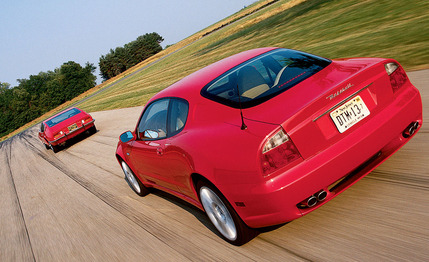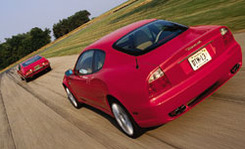 Road Test
Road Test
Say the word: Maserati. It's four full syllables of Italian glamour that sizzle on the tongue like fresh peeled garlic; a code word for a nation of people who both talk and sculpt with their fingers; and when the cars were going up in smoke, a swearword.
Ah, but never mind that now. Prodded by new owner Ferrari, the chromed trident is stirring from its fitful slumber and acting as though the disasters of the 1980s were just a nightmare. No problem. We're feeling generous.
In fact, we're willing to forget most of the past 30 years because the new Maserati Coupe really belongs to the 1960s (see sidebar). That's when the peninsula's bonny three — Ferrari, Lamborghini, and Maserati — made the payroll mainly with heavy, spacious, and plush GTs, or gran turismos to you. These vehicles balanced speed with comfort, presuming fuel was plentiful, her lady's hatboxes were ample, and the miles ahead were many.
Maserati Ghibli If our expectations for the new Maserati seem unduly high, blame the Ghibli.
If our expectations for the new Maserati seem unduly high, blame the Ghibli.
These days, most folks who order Italian prefer to scrunch into a screaming doorstop, at least judging by the tepid sales and soggy resale values of Ferrari's more modern four-seaters. The question being called by Ferrari is whether the Maserati Coupe, starting at a relatively bourgeois price of $84,625 for a manual-transmission GT or $87,921 for the paddle-shifted Cambiocorsa tested here, will attract enough cashier's checks to help revive not only Maserati in America but also the tradition of the big Italian GT.
Credentials for the mission? The Maserati Coupe has a hatful: matching pairs of leather buckets parked on enough acreage to accommodate a sellout crowd of adults; a chassis with both tectonic stability and a forgiving ride; and a big-bore V-8 with a Latin soul and a taste for road atlas. It all comes shrink-wrapped in a designer shell autographed by one of the boot's blue-chip metal stretchers, Italdesign-Giugiaro's own Giorgetto Giugiaro.
Oh, and the Maserati has some painful flaws, too, but none forward of the fire wall.
Twist the key, the bubble-gum-blue key, and the 385-hp DOHC 32-valve V-8's linebacker lungs go hhrrrummphh. Accompaniment is by a mechanical rhythm section made up of gnashing cogs, humming pumps, zinging chains, and whistling belts. Bored, stroked, and crank-configured to a deeper register than Ferrari's own 360 Modena V-8, the Maserati's redheaded Wurlitzer revs to its 7500-rpm redline sounding a bit more Corvette than Cavallino. It's still a very Italian wail, but in bass.
Actually, the cabin is pretty hushed at any top-gear cruising speed between the double-nickel and statutory reckless driving, the V-8's voice waiting to be summoned by a downshift (or not — there are buckets of torque) and a blaring blast into triple digits that will turn you toxic with adrenaline and peel the national-park stickers clean off a Winnebago.
Didn't we mention that the Maserati is brisk? The 265/35ZR-18 rear tires absolutely barbecue the road in first, chirp out second, and drive the Coupe even with a BMW M5 (September 2001) for the 4.7 seconds needed to reach 60 mph. The clock shows 110 at the end of a 13.2-second quarter-mile, 0.2 second and 5 mph fleeter than our long-term Porsche 911 Carrera loosened up by 40,000 miles of break-in (May 2001). Jaguar's XKR (January 2000) at 5.2 seconds to 60 mph and 13.8 seconds through the quarter will see nothing but rosso taillights, especially when they burn through a 70-to-0-mph 163-foot stop on a pedal that is firm and fade-hardened.